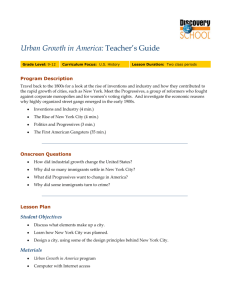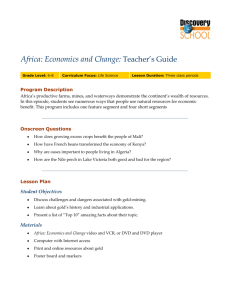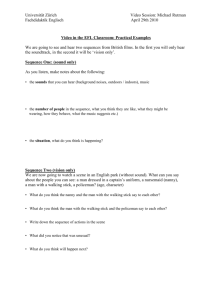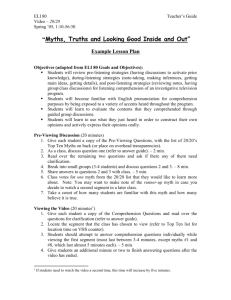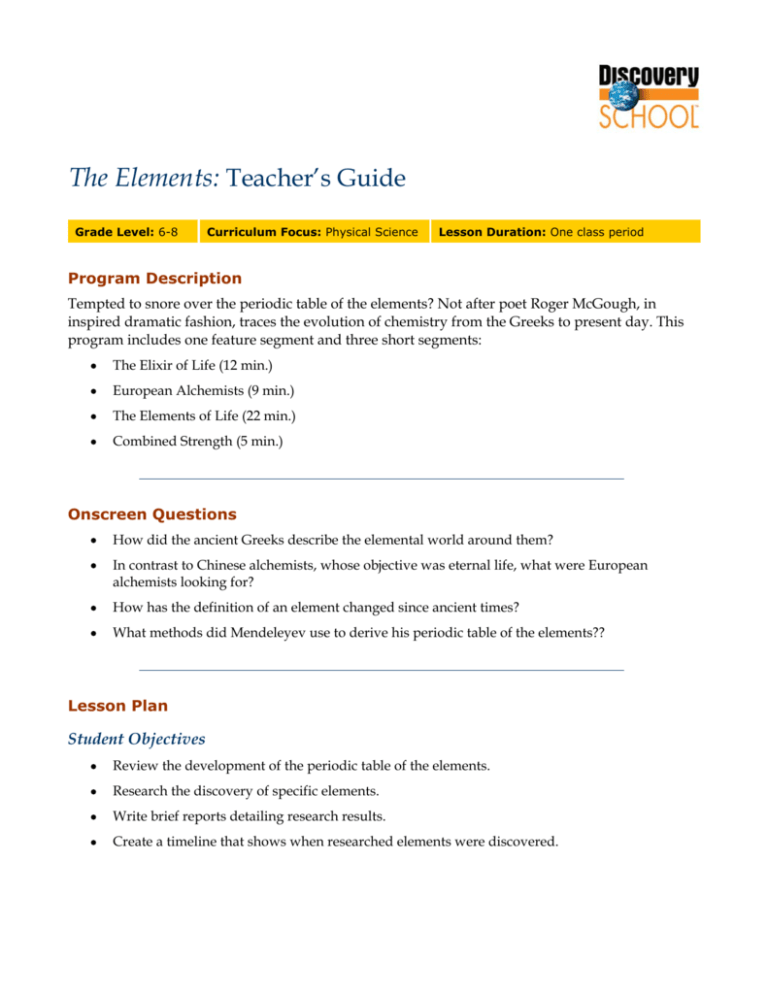
The Elements: Teacher’s Guide
Grade Level: 6-8
Curriculum Focus: Physical Science
Lesson Duration: One class period
Program Description
Tempted to snore over the periodic table of the elements? Not after poet Roger McGough, in
inspired dramatic fashion, traces the evolution of chemistry from the Greeks to present day. This
program includes one feature segment and three short segments:
•
The Elixir of Life (12 min.)
•
European Alchemists (9 min.)
•
The Elements of Life (22 min.)
•
Combined Strength (5 min.)
Onscreen Questions
•
How did the ancient Greeks describe the elemental world around them?
•
In contrast to Chinese alchemists, whose objective was eternal life, what were European
alchemists looking for?
•
How has the definition of an element changed since ancient times?
•
What methods did Mendeleyev use to derive his periodic table of the elements??
Lesson Plan
Student Objectives
•
Review the development of the periodic table of the elements.
•
Research the discovery of specific elements.
•
Write brief reports detailing research results.
•
Create a timeline that shows when researched elements were discovered.
The Elements: Teacher’s Guide
2
Materials
•
The Elements video and VCR, or DVD and DVD player
•
Periodic table of the elements
•
Research materials on the elements and important scientists
•
Computer with Internet access
Procedures
1. Review with students what they know about the periodic table of the elements. A good way to
begin the discussion is by viewing The Elements video.
2. Fill in any discussion holes by asking these questions: How did Mendeleyev know there were
gaps in the table? How was he able to predict the properties of the yet-to-be-discovered
elements? Have scientists since Mendeleyev discovered any of the missing elements?
3. Assign each student one element in the periodic table. Then, explain that their task is to research
the assigned element, finding answers to four questions:
•
What was the date of the element’s discovery?
•
Which scientist or scientists discovered the element?
•
Where was the element discovered?
•
Under what circumstances was it discovered?
4. Have students create a brief presentation about their element that includes the answers to the
four research questions. Encourage them to include information about the effect the element’s
discovery has had on society. For example, the isolation of iron led to the manufacturing of
weapons and tools during the Iron Age.
5. As students present their findings, work as a class to create an annotated time line that shows
the discovery dates of the researched elements.
Assessment
Use the following three-point rubric to evaluate students’ work during this lesson.
•
3 points: Students participated actively in the class discussion; showed a strong
understanding of how the periodic table was developed; successfully researched their
element; created an accurate, well-organized presentation that answered all four questions.
•
2 points: Students participated in the class discussion; showed a satisfactory understanding
of how the periodic table was developed; adequately researched their element; created a
somewhat organized presentation that answered all four questions with few errors.
•
1 point: Students did not participate in the class discussion; showed little understanding of
how the periodic table was developed; hardly researched their element; created a poorly
organized presentation that contained numerous errors or did not answer all four questions.
Published by Discovery Education. © 2005. All rights reserved.
The Elements: Teacher’s Guide
3
Vocabulary
alchemy
Definition: A medieval chemical science and speculative philosophy that included trying to
change base metals into gold
Context: Scholars during the Middle Ages practiced alchemy, mixing different substances in the
hopes of turning lead into gold.
compound
Definition: A distinct substance formed by the chemical union of two or more elements in
definite proportion by weight
Context: Water is a widely used chemical compound.
empirical
Definition: Originating in, or based on, observation or experience
Context: Rather than guessing which element interacts with carbon, scientists make their
decision using empirical evidence.
inert
Definition: Deficient in active properties; lacking a usual or anticipated chemical or biological
action
Context: Elements that don’t readily interact with other elements are considered inert.
organic
Definition: Of, relating to, or containing carbon compounds
Context: Carbon is the most important element in organic chemistry.
Academic Standards
National Academy of Sciences
The National Science Education Standards provide guidelines for teaching science as well as a
coherent vision of what it means to be scientifically literate for students in grades K-12. To view the
standards, visit http://books.nap.edu.
This lesson plan addresses the following science standard:
•
Physical Science: Properties and changes of properties in matter
Mid-continent Research for Education and Learning (McREL)
McREL’s Content Knowledge: A Compendium of Standards and Benchmarks for K-12 Education
addresses 14 content areas. To view the standards and benchmarks, visit http://www.mcrel.org/.
This lesson plan addresses the following national standards:
•
Science—Physical Sciences: Understands the structure and properties of matter
Published by Discovery Education. © 2005. All rights reserved.
The Elements: Teacher’s Guide
•
4
Language Arts—Viewing: Uses viewing skills and strategies to understand and interpret
visual media; Reading: Uses reading skills and strategies to understand and interpret a
variety of informational texts
Support Materials
Develop custom worksheets, educational puzzles, online quizzes, and more with the free teaching tools
offered on the Discoveryschool.com Web site. Create and print support materials, or save them to a
Custom Classroom account for future use. To learn more, visit
•
http://school.discovery.com/teachingtools/teachingtools.html
DVD Content
This program is available in an interactive DVD format. The following information and activities are
specific to the DVD version.
How To Use the DVD
The DVD starting screen has the following options:
Play Video—This plays the video from start to finish. There are no programmed stops, except by
using a remote control. With a computer, depending on the particular software player, a pause
button is included with the other video controls.
Video Index—Here the video is divided into four parts (see below), indicated by video thumbnail
icons. Watching all parts in sequence is similar to watching the video from start to finish. Brief
descriptions and total running times are noted for each part. To play a particular segment, press
Enter on the remote for TV playback; on a computer, click once to highlight a thumbnail and read
the accompanying text description and click again to start the video.
Curriculum Units—These are specially edited video segments pulled from different sections of the
video (see below). These nonlinear segments align with key ideas in the unit of instruction. They
include onscreen pre- and post-viewing questions, reproduced below in this Teacher’s Guide. Total
running times for these segments are noted. To play a particular segment, press Enter on the TV
remote or click once on the Curriculum Unit title on a computer.
Standards Link—Selecting this option displays a single screen that lists the national academic
standards the video addresses.
Teacher Resources—This screen gives the technical support number and Web site address.
Published by Discovery Education. © 2005. All rights reserved.
The Elements: Teacher’s Guide
5
Video Index
I. The Elixir of Life (12 min.)
Throughout the ages, many cultures have been fascinated with elements. See what Chinese
alchemists discovered about elements when searching for the elixir of life.
II. European Alchemists (9 min.)
European alchemists wanted to make the most coveted metal on Earth—gold. Explore the elements
discovered through European alchemy.
III. The Elements of Life (22 min.)
Years of experiments and research finally led Mendeleyev to his discovery of the periodic table.
Learn about the elements most essential to life.
IV. Combined Strength (5 min.)
Most elements are not found in pure form, but in groups called chemical compounds. Explore the
history of aspirin.
Curriculum Units
1. Four Earliest Elements
Pre-viewing question
Q: How many different elements can you name?
A: Answers will vary.
Post-viewing question
Q: How do we know that earth, air, fire, and water are not elements?
A: By modern definition, an element is a substance that cannot be broken down by chemical means
into simpler substances. Earth, air, fire, and water can all be broken down.
2. The Iron Age
Pre-viewing question
Q: What do you think is the most important known element?
A: Answers will vary.
Post-viewing question
Q: What would the world be like without iron?
A: Answers will vary.
3. The Madness of Mercury
Pre-viewing question
Q: What makes mercury such an intriguing element?
A: Answers will vary.
Published by Discovery Education. © 2005. All rights reserved.
The Elements: Teacher’s Guide
6
Post-viewing question
Q: Why were Victorian hatmakers prone to mercury poisoning?
A: Because they used mercury as a part of their job, hatmakers inhaled mercury vapors, which often
resulted in mercury poisoning.
4. Chinese Alchemy
Pre-viewing question
Q: What are some similarities between alchemy and modern science?
A: Answers will vary.
Post-viewing question
Q: What did the early Chinese do with gunpowder?
A: They began attaching bamboo tubes loaded with gunpowder to arrows, making rocket-powered
missiles. These early guns changed the way the Chinese fought.
5. European Alchemists
Pre-viewing question
Q: Would you rather have a formula for eternal life or one for abundant wealth?
A: Answers will vary.
Post-viewing question
Q: Why is gold so highly coveted?
A: Answers will vary.
6. Smuggling Fool’s Gold
Pre-viewing question
Q: Is breaking the law ever worth the risk?
A: Answers will vary.
Post-viewing question
Q: What is fool’s gold?
A: Pyrite, or fool’s gold, is a mineral that looks like it contains gold, but does not.
7. Isolating Phosphorus
Pre-viewing question
Q: What are the uses of phosphorus?
A: Answers will vary.
Post-viewing question
Q: Where can phosphorus be found?
A: It is present in most organic matter, living or dead.
Published by Discovery Education. © 2005. All rights reserved.
The Elements: Teacher’s Guide
7
8. Pure Air
Pre-viewing question
Q: Is air a pure substance?
A: No, air has more than one element.
Post-viewing question
Q: What elements are found in air?
A: Air is made up of about 78 percent nitrogen and 21 percent oxygen. The remaining one percent
is mostly argon, with small amounts of carbon dioxide, hydrogen, and other gases.
9. Inside Light Bulbs
Pre-viewing question
Q: How many elements are in a light bulb?
A: There are about 20 different elements in one light bulb.
Post-viewing question
Q: What will happen when there is no more tungsten?
A: Answers will vary.
10. A Reactive Triad
Pre-viewing question
Q: What is a triad?
A: It’s a group of three elements that have similar chemical properties.
Post-viewing question
Q: What is the relationship between sodium, potassium, and lithium?
A: Sodium, potassium, and lithium form a triad of highly reactive metals. In the human body,
sodium and potassium control the electrical impulses in nerves. If the balance of these two elements
in the brain is disrupted, it may cause manic depression. Lithium, which is not usually found in the
body, can be prescribed to restore the balance between sodium and potassium.
11. Diamonds and Carbon
Pre-viewing question
Q: What happens when a diamond is heated to the point of combustion?
A: It releases carbon dioxide.
Post-viewing question
Q: What makes carbon unique?
A: The chemical base of all life, carbon is the only element able to form long, stable chains of
molecules.
Published by Discovery Education. © 2005. All rights reserved.
The Elements: Teacher’s Guide
12. The Periodic Table
Pre-viewing question
Q: What is the function of the periodic law?
A: It groups elements according to their ability to react with one another.
Post-viewing question
Q: What is the periodic table used for?
A: Because it is a set of rules that defines chemical behavior, the periodic table enables chemists to
predict how elements will interact.
13. Chemical Compounds
Pre-viewing question
Q: Why aren’t most elements found in their pure form?
A: Answers will vary.
Post-viewing question
Q: What are some composites that you know of?
A: Answers will vary.
Published by Discovery Education. © 2005. All rights reserved.
8


